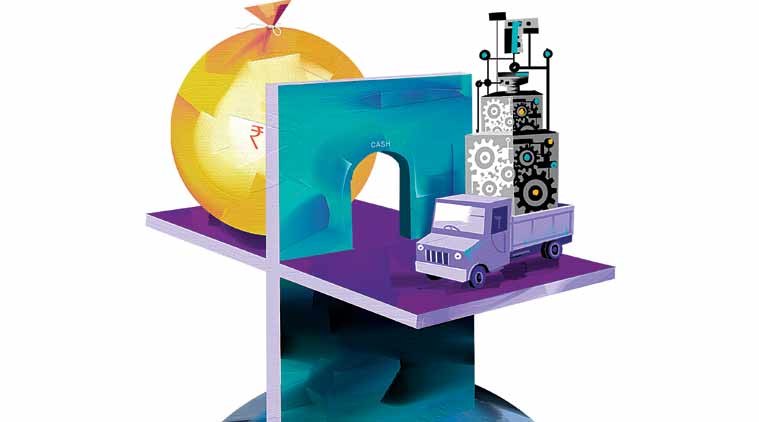- India
- International
Collateral for MSME loans: Monetising non-land assets
With a ‘moveable asset registry’ and a system of professional credit advisors, the government is planning to ease the constraints which are limiting fund flow to the cash-strapped sector.
 Small and medium industries (MSME) sector cumulatively contributes 37.5 per cent of India’s GDP. (Illustration: C R Sasikumar)
Small and medium industries (MSME) sector cumulatively contributes 37.5 per cent of India’s GDP. (Illustration: C R Sasikumar)Like most mid-sized industrial unit owners, Pradeep Mehta, who runs Ajay Meru Metals Pvt. Ltd., a sheet metal component manufacturing unit based in Noida’s Hosiery Complex on the outskirts of Delhi, finds it hard to raise working capital loans for his business. The biggest impediment being the lack of assets such as immovable property that can be offered as collateral for a bank loan, a recurrent constraint in the flow of credit to the micro, small and medium industries (MSME) sector that cumulatively contributes 37.5 per cent of India’s GDP with its network of 48 million enterprises employing an estimated 111.4 million people.
The government and the RBI are now in advanced stages of rolling out an intervention to specifically address this problem faced by the MSME sector, coming at a time when attempts to nudge India Inc biggies to step up investments have largely floundered.
The Centre, with the help of the banking regulator, is attempting two specific interventions. The first is setting up a ‘moveable asset registry’, a crucial financial platform that could have a multiplier effect on bank lending to small businesses. Alongside this, a system of professional credit advisors for the MSME sector is being proposed, which could help bridge the information gap between bank and the borrower.
[related-post]
For the creation of the ‘moveable asset registry’, the state-owned Central Registry of Securitisation Asset Reconstruction and Security Interest of India (Cersai), which provides a facility for registering charge on immovable property, is likely to be deputed to develop the registry. Most of the small business entrepreneurs do not possess immovable property to offer as collateral and instead they own machinery, stocks, receivables or livestock, which can be leveraged to obtain finance from banking channels if a ‘movable asset registry’ is available. The rollout of a moveable asset registry in countries such as China has resulted in a quantum jump in lending to small and medium enterprises.
The proposal for the ‘moveable asset registry’ in India would be on the lines of the provision in place for property mortgages, where the government has made it mandatory for all banks and financial institutions to register the mortgage created (security interest over property to secure loans) with Cersai within 30 days of creation of mortgage. The banks and financial institutions can access the central registry website by paying the prescribed fee and verify whether there are any encumbrances over the property to be funded, making it virtually impossible for any borrower to raise loans twice or more against the same property or raise loans using forged documents. A similar registry for movable assets is now being readied, which would make it possible by entrepreneurs to offer these as collateral, a senior government official involved in the exercise told The Indian Express.

Collateral facilitates credit by reducing the potential loss lenders face from loan defaults. While land and buildings are widely accepted as collateral for loans, the use of movable collateral (such as inventory, accounts receivable, livestock, crops, equipment and machinery) is restricted by non-existing or outdated secured transactions laws and registries. Reforming the movable collateral framework thus enables businesses to leverage the greatest part of their assets and obtain credit for growth.
“The proposal, if implemented, would be a big boost. Smaller units, who need working capital loans, are completely denied this facility by banks, even as the bigger units have access to these loans through the year. A moveable asset registry would give smaller entrepreneurs more options to raise capital,” said Mehta, who is the general secretary of the Noida Entrepreneurs Association, a lobby group representing MSME units in the industrial township.
Alongside the moveable asset registry, a system of professional credit advisors for MSMEs could help bridge the information gap between bank and the borrower, which is another major constraint in the flow of credit to the MSME sector currently. There is already a proposal to accord accreditation to few credit counselors who would act as facilitators for the small entrepreneurs to access the formal financial system. “Since MSMEs are typically enterprises with weak credit histories and inadequate expertise in preparing financial statements, credit counselors can help bridge the information gap and assist banks make better credit decisions,” an official said. The Reserve Bank of India is slated to hold consultations with all the stakeholders and guidelines for this are expected to be issued by September 2016.
The MSME push comes at a time when slow investment recovery amidst balance sheet adjustments of corporates continues to hinder investment demand. With capacity utilisation in the organised industrial sector estimated at 72.5 per cent, the revival of private investment is projected to be tepid.
Globally, collateral registries for movable assets have been a big plus. According to a 2011 study by IFC, the World Bank’s private sector lending arm, that used firm-level surveys for up to 73 countries to explore the impact of introducing collateral registries for movable assets on firms’ access to bank finance found that this significantly increased firms’ access to bank finance. There was also evidence that this effect is larger among smaller and younger firms.
Global experiences
CHINA: After the enactment of the Property Law in October 2007, the People’s Bank of China Credit Information Center created a national online registry for security interests in receivables, the first of its kind in China that incorporated all the key features of a modern movable collateral registry. An independent evaluation commissioned by IFC in 2011 reported an impressive impact that included the percentage of moveable asset-based lending in China going up from 12 per cent pre-reform to around 20 per cent afterwards. It reported over 3,85,000 registrations representing loans with a value estimated at over $3.5 trillion, more than 4,90,000 searches have been performed in the registry. Of the $3.5 trillion in new financing facilitated that year, approximately $1.1 trillion corresponded to SME financing. Among the registry’s 3,000-plus customers that year, users included banks, guarantee companies, law firms, finance companies, and pawn shops.
GHANA: In 2008 Ghana embarked upon a reform of its movable collateral legal framework and registry. Before the reform took place, the use of movable collateral in Ghana was a key constraint for SME financing. Upon enactment of the “Borrowers and Lenders Act” 2008, the Bank of Ghana established a collateral registry. With IFC support, the Bank of Ghana updated the Borrowers and Lenders Act and redesigned the Registry system to align more with international best practice. Over 20,000 loans were reported to have been registered since March 2010. The total financing secured with movable property account for more than $800 million. Around 63 per cent of Banks and other Financial Institutions used the registry in Ghana that year. The new secured transactions system led to the development of productive supply chain financing schemes in the mining and oil industry, benefiting more than 100 local SMEs creating hundreds of new jobs.
Apr 19: Latest News
- 01
- 02
- 03
- 04
- 05






































